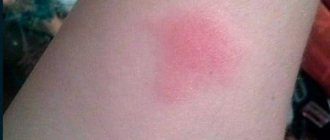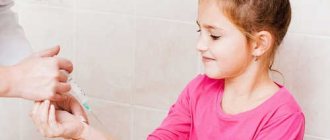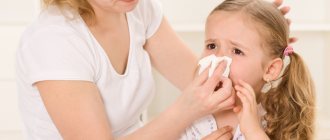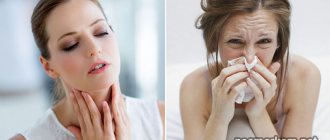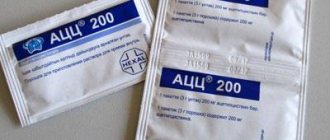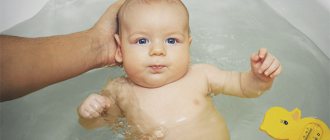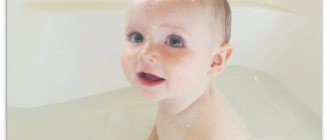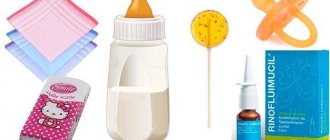Mantoux is not performed for coughs. If it was caused by an infectious disease (influenza, whooping cough, bronchitis and others), then you should wait for complete recovery and be diagnosed in a month. For an allergic cough, the test is performed only in the remission stage, that is, after the symptoms have subsided. Before Mantoux, it is mandatory to interview parents and examine the child to exclude other contraindications (skin diseases, epilepsy, exacerbation of chronic diseases).
If a cough occurs after the test, then most often it is not related to the test, and you need to find the cause (usually an infection of the respiratory tract or nasopharynx). Less commonly, a cough reflex is a manifestation of high sensitivity to tuberculin, in which case a consultation with an immunologist (allergist) will be required.
Is it possible to use Mantu for coughs and illnesses?
When coughing, Mantoux cannot be given, since a test with tuberculin shows the state of immunity to infection, and it changes if the body fights the disease during the diagnosis period. The main causes of different types of cough are listed in the table.
| Character of the cough | Origin | Examples of diagnoses |
| Superficial (coughing) | Viral infection | Influenza, parainfluenza, adenovirus |
| Inflammation of the ENT organs | Pharyngitis, tonsillitis, nasopharyngitis | |
| Childhood diseases | Measles, rubella (onset), parawhooping cough | |
| Rare causes | Medicines, neurosis, thyroid diseases | |
| Dry deep | Respiratory tract damage | Whooping cough, laryngitis, tracheitis, bronchitis |
| Infection | Tuberculosis | |
| Non-inflammatory pathologies | Tumor | |
| Extrapulmonary diseases | Diseases of the esophagus, heart, pericardial sac | |
| Wet | Inflammation of the respiratory system | Bronchitis, pneumonia, laryngotracheitis |
| Other | Complications of heart disease, tumor | |
| Barking | Infections | Diphtheria, virus, whooping cough, parainfluenza, false croup |
| Rare | Congenital pathologies of the larynx, tick-borne borreliosis |
All infectious diseases cause a reaction of the immune system in response to the penetration of viruses or bacteria, which inevitably affects the result of the Mantoux test. With a non-inflammatory cough, violations of the reliability of the test are often associated with a general weakening of the body.
We recommend reading about whether Mantu is worth doing after an illness. From the article you will learn why you can’t do Mantoux after an illness, whether it can be done a week after chickenpox, measles, where to get a medical outlet from Mantoux after an illness. And here is more information about how to reasonably draw up a Mantoux waiver.
Impact on examination
It is impossible to accurately predict the outcome of a cough skin test, since the size of the papule may increase or decrease. This depends on the stage of the infectious disease and the patient’s individual reaction to the introduction of the allergen. Since Mantoux is a diagnostic method, it is important to completely exclude external and internal factors that affect sensitivity to tuberculin:
- helminthic infection;
- intestinal dysbiosis;
- prolonged exposure to the sun;
- administration of Interferon, plasma substitutes, Penicillin, Streptomycin;
- taking hormones, vitamins A, C and D;
- frequent colds.
How long after recovery can you
The general rule for performing a Mantoux skin test after an illness is that at least one month must pass after recovery. At the same time, it is taken into account that the very presence of a cough, even at normal temperature, refers to the residual effects of the infection. You need to wait for it to completely disappear and only then undergo tuberculin diagnostics.
Is it possible to do Mantoux when a child has a cough: possible consequences, contraindications
To detect tuberculosis in a person in time, the Mantoux test is used. Despite the safety of this proven method for detecting the disease, there are a number of limitations. The doctor decides whether Mantoux can be given to a child for coughing and informs the parents. During the period of colds, the body is weakened, so it is important to know the consequences of diagnostics.
Is it possible for a child to give Mantoux for a cough?
The pediatrician decides to place Mantoux after a complete examination of the child. Parents fill out a questionnaire where they indicate past illnesses and talk about the child’s general condition at the moment - does he have a cough, snot, how long has he been sick. Permission for tuberculin diagnostics must be recorded by the doctor and parents.
Mantoux is postponed if symptoms of a respiratory infection are present. At this moment, all the patient’s forces are aimed at fighting it. If a child coughs, has a fever, or a runny nose, then the test can give a false positive reaction.
Impact on study results
If the Mantoux test is done during a cold, the injection site does not react as it should normally. Its size is influenced not by the residual effects of a cold, but by an acute inflammatory process in the body - bronchitis, tracheitis. Parents and their child will have to conduct a series of studies and visit specialists to prove that they do not have tuberculosis.
The redness limit may be much greater than normal. The injection site begins to fester and a small ulcer appears. When assessing the test result, the compaction value is taken into account.
Consequences for the child
If at the time of the Mantoux test there is a wet cough or other residual effects, the child tolerates the procedure easily and without complications. If they are present, the condition can be alleviated by correcting it with medications.
A child’s body reacts completely differently during the acute phase of a cold. Possible side effects include:
- allergic reactions;
- change in stool;
- runny nose;
- changes in behavior.
Is it allowed to make mantu for an allergic cough?
If a child suffers from an allergic cough that is dry and paroxysmal in nature, this is a pre-asthmatic condition. Injecting the sample drug at this point may lead to adverse effects. For children suffering from allergies, the test should be performed during a period of stable remission, that is, in the absence of obvious symptoms for more than a month.
Don’t worry if the papule that appears after Mantoux exceeds the norm. This may be a sign of an allergy to the components included in the composition. In emergency cases, if tuberculosis is suspected, a cough test is also performed.
Contraindications for the test
Every parent should know that contraindications to tuberculin injection are not only cough and runny nose, but also other symptoms and conditions:
- infectious diseases;
- chronic diseases in the acute phase;
- disorders in the gastrointestinal tract;
- elevated temperature;
- rheumatism in the acute phase;
- epilepsy;
- exacerbation of allergies, accompanied by a runny nose and cough;
- severe skin lesions.
In these cases, it is worth refusing to perform Mantoux, since the condition can be aggravated and without obtaining a reliable result.
By order of the Ministry of Health, it is prohibited to conduct Mantoux tests if quarantine is declared in a child care facility.
The most important contraindication is intolerance to tuberculin and its constituent substances. Parents need to know about this feature of the child’s body and inform the doctor in advance.
How long after a cold can you do it?
The vaccination schedule must be monitored very carefully. Experts advise carrying out a tuberculin test on Friday so that the child will be under parental supervision until Monday. The most accurate data about Mantoux is obtained exactly 72 hours after its placement.
If the child was sick and the tuberculin test was postponed for this reason, it is performed 2 weeks after recovery. Combining Mantoux with any vaccinations is contraindicated.
To avoid complications, a time interval of 30 days is required between them.
Directly on the day of the procedure, the child’s body temperature and throat condition are checked in the children’s office to rule out an incipient infectious disease.
What to do if a cough appears after Mantoux?
A cough that appears after Mantoux signals that not everything went smoothly. Only a doctor who you should contact can determine the cause.
Most often the cause is:
- a cold not noticed at the time of testing;
- infection immediately after the procedure;
- tendency to allergies;
- vomiting due to drug overdose or poisoning.
If the child’s temperature has increased slightly (up to 37.2 ⁰C), his hand has turned a little red, there is no need to worry, these are temporary phenomena, they should pass in a day.
You should consult a doctor if you have a number of symptoms:
- severe cough;
- significant increase in temperature;
- swelling of the hand, its swelling;
- pain at the injection site;
- headaches, dizziness;
- choking, shortness of breath;
- the appearance of rashes, ulcers, blisters on the skin.
If a cough appears after the Mantoux test, action should be taken as quickly as possible. If it is combined with a rash and there is no fever, take antihistamines; if you have a red throat, take antiviral drugs. An uncontrollable cough and an increase in temperature to 38 ⁰C or higher requires immediate medical attention or calling an ambulance.
Yulia Kalashnik
Source: https://VipLor.ru/kashel/mozhno-li-delat-mantu
Is it possible to do Mantoux if a child coughs due to allergies?
If a child coughs due to allergies (for example, allergic bronchitis, tracheitis, laryngitis), then Mantoux is prohibited. Any reaction to an allergen occurs with the formation of protective proteins (antibodies), which will affect sensitivity to the introduction of tuberculin into the skin.
An allergic cough is characterized by bronchospasm (attacks, shortness of breath or suffocation), it occurs like an infectious cough (with sneezing and lacrimation), but the temperature is not typical for it, and there is no sputum mixed with pus. The presence of a cough reflex during allergies is a sign of exacerbation of the disease, its active phase.
Such patients need to undergo treatment, and then take antiallergic drugs 3 days before the Mantoux test. Sometimes the pediatrician recommends their use after the test. There is no need to take allergy medications on your own.
Is it possible to give Mantu for a cough: reaction, how to vaccinate, pediatricians’ opinion, consequences
The Mantoux test is an allergy test that is done annually to every child in order to find out whether immunity against tuberculosis is present in his body.
Before carrying out the test, the specialist must examine the child and assess his state of health. The pediatrician decides to do Mantoux for illnesses or to postpone this immunological test until the child has completely recovered.
Symptoms of a cold, such as a runny nose and cough, may affect the test result.
What is Mantoux test
Children are especially sensitive to tuberculosis, so BCG is the first vaccination given to newborns in the maternity hospital. The vaccine is administered to a child in the first days of life and does not require a preliminary allergy test.
If the baby was not given BCG at birth, then after two months of age a tuberculin test must be done before vaccination, since by this time the child may already have contact with sick people and is at risk of becoming infected.
After the BCG vaccination, a tuberculosis bacillus remains in the baby’s body, which, when interacting with tuberculin, can give a positive response. Therefore, children under 12 months are not given Mantoux, since the test will not be objective.
Mantoux is not a vaccination, it is an allergy test that does not create immunity to tuberculosis. The test is carried out using tuberculin, a drug that is a mixture of protein antigens obtained after neutralizing tuberculosis bacteria.
The procedure for performing tuberculin diagnostics is as follows:
Conducting tuberculin diagnostics
- the skin on the inside of the arm above the wrist is disinfected;
- the syringe is placed parallel to the arm and the drug is injected under the skin;
- A papule, the so-called “button,” forms at the injection site.
A papule is a local reaction to tuberculin. 72 hours after administration of the drug, its diameter is assessed using a regular transparent ruler.
The Mantoux test is done to all children, even those who have a medical exemption from vaccinations. The manipulation is carried out once a year until the age of 18 in order to be able to assess the child’s health.
After reaching the age of eighteen, it is already possible to carry out a fluorographic examination, which makes it possible to exclude not only pulmonary tuberculosis, but also other pathologies of the lungs and heart.
An exception may be children prone to allergic reactions.
Is it possible to use Mantu for a cough?
Just a few decades ago, tuberculin diagnostics were performed on all children without exception for any health condition. Currently the approach is slightly different:
The decision to conduct tuberculin diagnostics is made only after examining the child by a pediatrician
- the pediatrician examines the child and decides on the advisability of conducting a tuberculin test;
- parents fill out a questionnaire in which they talk in detail about the child’s health status and past illnesses;
- permission to conduct the test must be from both the parents and the doctor.
Taking into account the health characteristics of the baby, the procedure can be postponed or carried out as planned.
Cough is a protective reaction of the body to an irritant or inflammatory process. The reasons may be:
- cold;
- bronchospasm;
- allergy;
- external irritants (dust, harmful substances);
- lung disease.
If a child has a cold and coughs, then there is an infection in the body that affects the upper respiratory tract. All protective resources of the child’s body are aimed at combating the cause of the disease. The introduction of even a small amount of the pathogen into a weakened body can cause a violent reaction and give a false positive result for a tuberculin test.
Making Mantoux when coughing is dangerous for a child’s health
It is possible that a child may have a slight cough, and the doctor may not notice it. Parents should focus on current or recent illness. Carrying out an allergy test can aggravate the situation and intensify the cough or intensify it.
It is better not to do Mantoux if the child is coughing, since there is a high probability that the consequence of the administration of tuberculin will be an exacerbation of the cough. This manifestation is not evidence of infection with Koch's bacillus. This may indicate that the body has encountered an infection against the background of a weakened immune system.
At the time of the test, the child must be completely healthy to exclude false reactions. To fully restore the body after an illness, another 10-14 days are required after recovery.
Untreated upper respiratory tract diseases and residual cough can give not only a false positive, but also a false negative result.
This is explained by a change in the body's sensitivity to tuberculin.
Mantoux for allergic cough
If a child is prone to allergies, then he may develop a specific cough, which differs from a cold in the following ways:
- the cough is dry, not accompanied by sputum production;
- manifests itself in attacks and can cause asthma attacks;
- often accompanied by a runny nose and sneezing;
- manifests itself more at night, to a lesser extent during the day.
An allergic cough can be a reaction to an external irritant: pet hair, seasonal flowering of plants, food allergens, taking medications. Any allergies can affect the Mantoux reaction and give a false result.
A child prone to allergies should be prepared in advance for Mantoux:
- do not introduce new foods into the diet 5 days before the procedure and 3 days after;
- do not visit public places and entertainment venues;
- on the day of the allergy test, take an antihistamine.
The rules for caring for the injection site are the same for all children. It is forbidden:
- wet your hand;
- cover with a plaster;
- comb;
- treat with brilliant green and other means.
You can go for walks and breathe fresh air after the Mantoux test.
Possible consequences
The reaction is checked after 3 days, only the size of the lump is measured - no attention is paid to the redness of the skin. If there is no compaction or redness at the site of tuberculin injection, and the papule itself does not exceed 1 mm, then this may mean that the child’s body has never encountered the tuberculosis bacterium.
If the result is questionable, based on the size of the papule, the TB doctor determines the likelihood of infection:
The reaction to tuberculin is checked after three days
- less than 5 mm with redness, but without compaction – a questionable result;
- 5-9 mm – weakly positive;
- 10-14 mm – medium intensity;
- 15 mm or more – a pronounced hyperergic reaction, a very high probability of infection with Koch’s bacillus.
In case of any doubtful result, before treating tuberculosis, it is necessary to undergo additional tests for a final diagnosis.
Other contraindications for children
It is prohibited to perform a Mantoux test on a child if:
- skin disease - dermatitis, eczema, psoriasis, neurodermatitis or the presence of rashes (if the diagnosis is not specified);
- infections in the acute stage;
- exacerbation of chronic inflammation;
- deterioration of a non-inflammatory disease (for example, decompensation of diabetes mellitus);
- allergic and infectious-allergic diseases beyond the stage of remission (rheumatism, bronchial asthma, seasonal runny nose);
- tuberculin intolerance (severe allergy to injection in the past with bronchospasm, swelling, widespread rash);
- epilepsy.
You cannot test during quarantine at the school or kindergarten the child attends. If you have been vaccinated against infections (for example, DPT or influenza), then at least a month must pass after it.
Causes of cough after Mantoux
If there was no cough before the Mantoux test, but it appeared after the test, then it is caused by:
- acute viral or bacterial infection (most often);
- allergies not related to tuberculin;
- allergic reaction to tuberculin;
- exacerbation of chronic inflammation of the bronchi, lungs, trachea, nasopharynx, larynx.
Allergic reaction to tuberculin
To establish the exact cause, it is necessary to undergo a comprehensive examination.
Other complications after the test
Common adverse reactions after the Mantoux test include general malaise and itching in the injection area. Less common:
- widespread rash;
- short-term increase in temperature to 37.1-37.3 degrees;
- dizziness, headache.
With tuberculosis infection, the body reacts violently to the introduction of tuberculin: the papule increases to 15-17 mm in diameter or more, bubbles appear in the sample area, and lymph nodes may become enlarged.
Is it possible to do a Mantoux test when coughing?
Carrying out a Mantoux or immunological (tuberculin) test is mandatory for everyone in childhood. This procedure shows and establishes the body’s contact with the pathogen – Koch’s bacillus (tuberculosis).
Recommended for everyone except those who have contraindications. Many parents think that the procedure is harmful and hazardous to health. In fact, the test helps to identify the problem in a timely manner. If there are contraindications, testing is postponed to another day.
The papule is made with an insulin syringe just above the wrist. Everyone knows that the injection site should not be wet. But few people know that foods can be used to redden the injection site. The time for the “work” of the administered drug is exactly 72 hours. After which measurements of the papule are taken:
| froze | state | meaning |
| From 15 cm | The body’s reaction can be not only in the form of a huge red spot, but also like an abscess | Indicates infection with tuberculin bacillus. The infection is spreading rapidly. Need help, then treat with antibiotics |
| 5-10 cm | Risk group. Intermediate state | An increase in the papule to the specified size indicates a possible infection. This reaction is possible after suffering from pneumonia, colds, or flu. |
| Less than 5 cm | Norm | The vaccination was successful. There is no need to worry, there is no need to undergo additional examination. Evidence of a negative reaction of the body to the pathogen |
Cough after Mantoux in a child: what to do
Since a child’s cough after Mantoux is usually associated with the onset of diseases of the respiratory system and nasopharynx, it is necessary first of all to undergo the following examination:
- examination by an ENT doctor with taking smears for culture;
- sputum analysis;
- chest x-ray (in case of doubtful data, computed tomography is prescribed);
- blood tests: general, T-spot or quantiferon test to exclude tuberculosis infection;
- immunological examination to determine the causative agent of infection (PCR - polymerase chain reaction, ELISA - enzyme-linked immunosorbent assay), as well as the state of immunity (immunogram);
- examination of the bronchi (bronchoscopy).
Examination by an ENT doctor
If, as a result, the cause of the cough is not found, then the pediatrician can expand the plan by:
- radiography of the esophagus;
- ECG and echocardiography;
- immunologist consultations.
Treatment will depend on the disease identified. General recommendations include:
- avoiding hypothermia;
- warm drink;
- exclusion of hard and spicy foods, carbonated drinks.
When the throat is irritated and inflamed due to a cold, it is often possible to limit yourself to rinsing and inhalation. For dry and wet cough of infectious origin, antibiotics and drugs to facilitate coughing and thin sputum are prescribed. For chronic cough, physiotherapeutic procedures and massage are recommended after completion of antibacterial therapy.
For allergic coughs, medications are used to reduce the reaction to the allergen (antihistamines); medications are often needed to dilate the bronchi and ease breathing. If tuberculosis is detected during the examination, then specific anti-tuberculosis drugs are indicated.
We recommend reading about the causes of Mantoux allergy. From the article you will learn about what provokes the development of allergies to the Mantoux vaccine, who is more susceptible to allergies among children, what to do if allergy symptoms appear in a child. And here is more information about why the temperature may rise after Mantoux.
Mantoux is not performed when coughing, as infection or allergies can distort the test results. After the symptoms of the disease completely disappear, at least a month must pass.
Cough after Mantoux test
The introduction of tuberculin affects the immune system and weakens it somewhat. If a few days before the allergy test the child was in direct contact with sick people, then the risk of infection increases. If a cough appears after the Mantoux test, this does not mean that the child has been infected with tuberculosis. This is probably the start of a respiratory infection.
After the administration of tuberculin, an allergic reaction may develop, which manifests itself:
- cough that gets worse;
- nausea and vomiting;
- nosebleeds;
- skin rashes;
- itching and burning at the injection site.
Individual intolerance to tuberculin is possible, which is important to report not only to doctors, but also to employees of children's educational institutions. The Mantoux test is a simple, safe and inexpensive test that can determine whether a child has been exposed to the bacterium that causes tuberculosis.
Cough is not the only contraindication to an allergy test. If a child is sick, then you should not subject the body to additional stress.
The Mantoux test is a simple, safe and inexpensive test that can determine whether a child has been exposed to the bacterium that causes tuberculosis. Cough is not the only contraindication to an allergy test. If a child is sick, then you should not subject the body to additional stress.
The benefit of the research must outweigh the possible harm, and performing the Mantoux test on a sick child means exposing him to additional risk. There is an opinion that this technique is not always reliable.
Modern doctors use alternative research methods to diagnose tuberculosis infection at the initial stage. To check the resistance of a child’s body to Koch’s bacillus, you can do an enzyme-linked immunosorbent test (ELISA) or PCR. The results of complex analyzes make it possible to determine various forms of lung damage at different stages.
source
